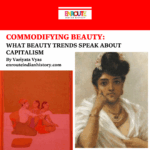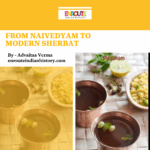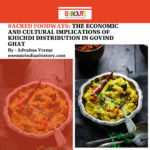Article Written By EIH Researcher And Writer
Aparnna R Menon
The realm of music captures the cultural life and zeal of the region and its people that may goes unnoticed otherwise. The case of Punjab is no different. They knit together strands of various themes, stories, cultural traditions and emotions to make a beautiful mosaic that can be largely termed the music of Punjab. Commercially produced Punjabi music showcased especially in Bollywood has frequently been drawn as a representative image of Punjab. While this has helped in cultural promotions, scholars like Gibb Schreffler offers a fresh perspective on how these have resulted in the sidelining of several other musicians and music traditions of the region. An interesting theme to delve into in this regard is the folk music of Punjab; an element that displays the true essence of Punjab and its vigour.
The term “folk music” a western label imprinted onto this genre of music, lacks for it turns a blind eye to the nuances and intricacies that the music is a part of. Deeply entrenched into the cultural system, these lok geet cannot be seen restricted to geographical boundaries since they transcend barriers to be carried fondly by the people who sustain this tradition. Stories and emotions are interwoven into the songs and they speak in a language accessible to all. They are wholehearted expressions participatory in nature and never tied to the aspect of formal training, payment or audience except for a few instances. Set in the picturesque ambience of Punjab, these lok geet are impromptu songs sung while the villagers occupy themselves with their chores and duties. Sohinder Singh Bedi, a renowned Punjabi folklorist, points out how the simplistic rhythm and beats of Punjabi folk music emerge from daily activities like the sound of the grinding stone, the drone of a spinning wheel, the beat of the horse’s hooves etc. What would seem monotonous is refined into symmetrical patterns to put forth some of the best tunes that songs live on.
The folk tunes vary as they travel from east to west. In the west on the plains of Singh Sagar Doab, certain forms like Mahiya and Dhola are predominant. Certain songs previously popular in the west have also migrated to the east. Encompassed in the Punjab folk tradition, there are varied types of lok geet with distinct styles and contexts used in specific events. The most common one, as studies by Nahar Singh and R S Gill show, is the tapa (plural tape), a couplet that displays parts of a particular emotion, mood, idea, or situation. An assortment of different tape constitutes a boli (plural bolian) sung by an individual at an increasing pace with the culminating verse being repeated by the group. Lambe gaunh (long songs) are performed by two pairs in a dialogue. Some songs are linked to certain rituals like kirne and alauhnhian which are bereavement songs performed collectively. While bolians, tape and proverbs are for both men and women, a prominent feature of these songs is the large participation of women. Women, also seen as guardians of culture, form major participants in this tradition, especially when it intersects with ritual occasions like weddings, mourning and festivals like Tian. Instruments are not primary to folk music although songs sung on special occasions are accompanied by instruments mostly, the dholak. The unavailability of dholak would mean modification by using earthen pitchers to create beats. The Bhatts and Dhadis, professional singers enchant people with their ballads at the end of the day which feature folk instruments like Algoza, iktara, and sarangi that enhance allure. For women, it is the jingling of the bangles, chorus, utensils, and clapping of the hands and bells that go with more festive and dance-oriented songs. Loris or lullabies also resonate with folk elements.
The tales embedded in these songs are as diverse as it can be. It ranges from romance to heroic to devotional stories. They provide windows into the cultural life, practices, morals and ethical values cherished and handed down across generations. The Punjabi rebellious spirit, bravery, love, and sacrifice feature strongly in the songs. Mirza Sahiban, the tragic love story, is sung in the tune Sad (call) or the mournful tune that evokes much pain in the listeners just like the story. The tales of Puran Bhagat, Gopi Chand and Hakeekat Rai constitute some of the devotional folklore that has seeped into the songs. Stressing the oneness of divinity, certain lok geet renounce religious divisions and seek harmony.
‘The brahmins and mullahs throw dust and the truth is left behind
Allah, Vahiguru and Khudha’s name is one. The world is deluded’
Raja Rasalu, Sucha Singh Surma and Jeuna Mor fall under the heroic category. The historical context of world wars sets the background of some songs that express tragedy and celebrate the bravery of soldiers lost in the war. Along with this, the voices of resistance against ruling classes and social changes are also recorded in the songs. A translation of a lok geet reads,
‘They capture and sell virgin daughters
Such is the reign of the evil ones
I’ll never ride on your train
I’ll ride on the horse carriage
God is dead and the Gods have run off. It’s the European’s reign.’
Some other underlying themes include family relations, clan and celebration of community relations. Aspects of patriarchy, a reflection of society, have also been ingrained into the songs seen in the mention of the preference for a male child and the celebration that follows in the birth of one. However, what is striking is the cultural spaces these folk art created for women to channelise their emotions, fears, dreams, sexual needs, frustration and more. The beauty of womanhood is exhibited in the songs in which women bond over common domestic and marital issues and grant reassurance in times of distress.
The beauty of these candid expressions also lay in the absence of refinement of line, form or diction of poetry that has made it accessible to all. Carried across generations by word of mouth, folk songs and the dance that it was mostly associated with have helped break the monotony of life and bring liveliness. Though it’s nostalgia and curiosity that draw people to these folk traditions now, what’s often forgotten is the morals and values nurtured in these. It captures the changes brought by time, and as an oral tradition, it was altered to cater to the needs of new audiences and new social and political situations. The songs live on, still pertinent to the present audience and the situations time has brought to us.
BIBLIOGRAPHY
Narula, S. C. “Folk Songs of Punjab.” Indian Literature, vol. 45, no. 3 (203), 2001, pp. 182–92. JSTOR, http://www.jstor.org/stable/23344116. Accessed 1 Apr. 2023.
Bedī, Sohindara Siṅgha Waṇajārā. Folk music and dances in Folklore of Punjab. NBT India, 2006.
Schreffler, Gibb Stuart. “Gibb Schreffler: Music and Musicians in Punjab 1 Music and Musicians in Punjab: An Introduction to the Special Issue.” (2011).
Singh, Nahar, and R S Gill. Folk Songs of Punjab.

















